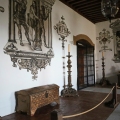The Great Lavra of Mount Athos (Megisti Lavra) is the oldest and largest monastery on Mount Athos, Greece, and ranks first in the monastic hierarchy among the twenty monasteries. Founded in 963 AD by Saint Athanasius the Athonite, with support from Byzantine Emperor Nicephorus Phocas, the monastery was built like a fortress and includes many chapels, cells, hermitages, and sketes. Its katholikon is known for a richly carved iconostasis and the miraculous icon of the Virgin Koukouzeliotissa. The sealed tomb of Saint Athanasius is deeply revered.
Throughout its history, the monastery hosted thousands of monks and played a key role in Orthodox monasticism. It flourished in the 10th and 14th centuries and, in the 18th century, housed Greece’s oldest operating printing press. Today, it has 21 internal chapels, 60 hermitages, and numerous functioning cells, managing vast lands across 72,000 acres. It continues its cenobitic life under the guidance of Archimandrite Prodromos Lavriotis, remaining a spiritual, historical, and pilgrimage center of Eastern Orthodoxy.
The Great Lavra is also a central place for Hesychasm, the contemplative mystical tradition of Eastern Orthodoxy, having been the home of key spiritual figures such as Gregory Palamas, advocate of the Jesus Prayer. The monastery houses invaluable manuscripts, relics, and ancient frescoes, remaining a beacon of Orthodox monastic life today. Its vast lands include remote hermitages and cells in areas like Karoulia and Katounakia, where monks live in strict solitude and asceticism. Despite its secluded location, the Great Lavra attracts pilgrims from around the world, drawn by its spiritual legacy, sacred art, and enduring monastic rhythm of prayer and silence.
- Address
Mount Athos 630 86, Greece - Web
https://www.athoszone.com/ - Visiting Hours
See here https://www.athoszone.com/odigies-gia-proskynites/ - What to see
Invaluable manuscripts, relics, and ancient frescoes




